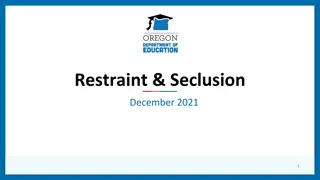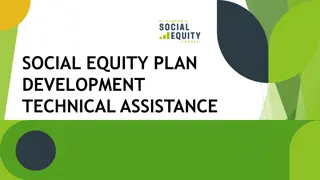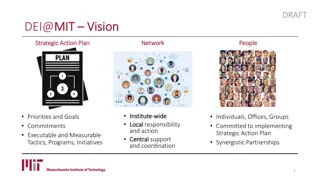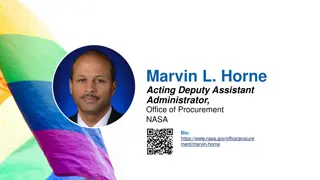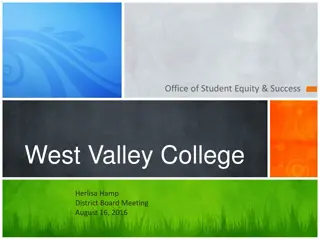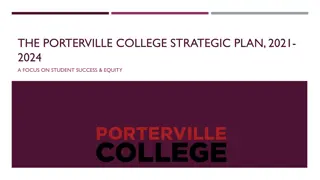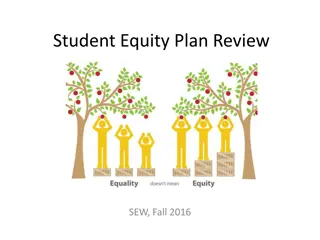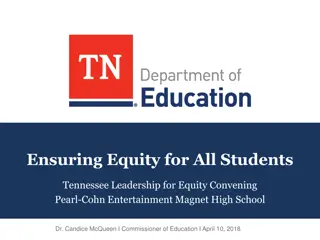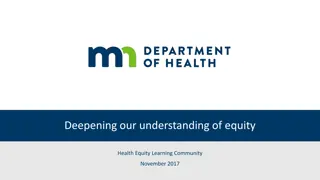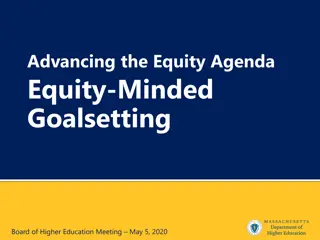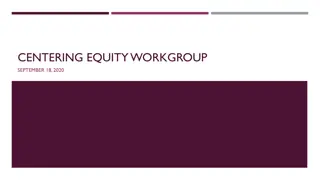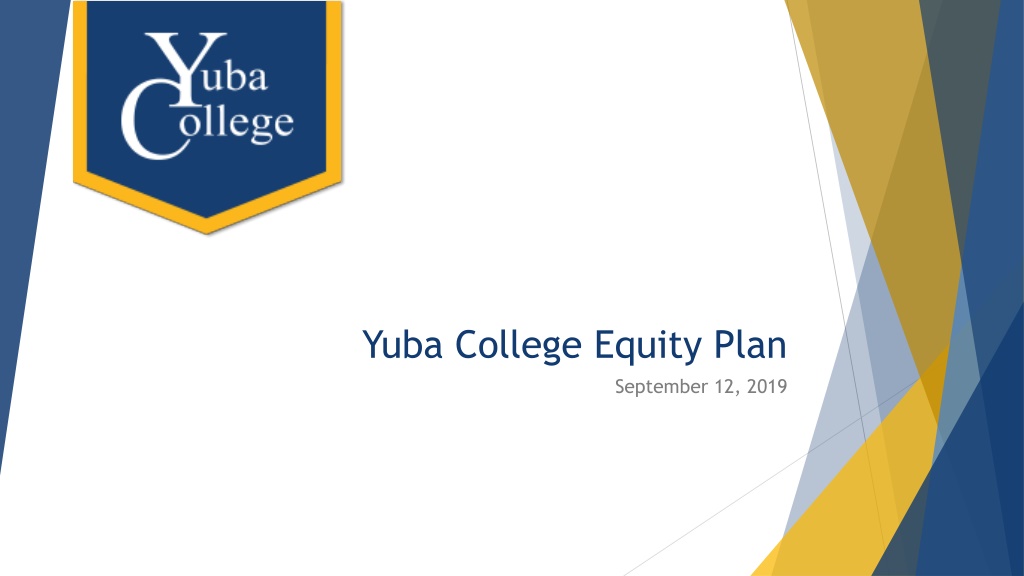
Understanding Equity Plans in Higher Education
Explore Yuba College Equity Plan focusing on boosting student achievement, addressing disproportionate impact, and striving for full equity. Learn about the Leadership for Equity, Achievement, and Diversity Committee, enrollment statistics, and retention rates. Discover what equity means and how it differs from equality.
Download Presentation

Please find below an Image/Link to download the presentation.
The content on the website is provided AS IS for your information and personal use only. It may not be sold, licensed, or shared on other websites without obtaining consent from the author. If you encounter any issues during the download, it is possible that the publisher has removed the file from their server.
You are allowed to download the files provided on this website for personal or commercial use, subject to the condition that they are used lawfully. All files are the property of their respective owners.
The content on the website is provided AS IS for your information and personal use only. It may not be sold, licensed, or shared on other websites without obtaining consent from the author.
E N D
Presentation Transcript
Yuba College Equity Plan September 12, 2019
What is Equity? Equality Equity
Equity Plan Required by Title 3 of Education Code, Section 78220 Focuses on boosting achievement as measured by specific success indicators Establishes key student populations for which disproportionate impact must be identified and addressed Identifies the total number of students needed to achieve full equity
Leadership for Equity, Achievement, and Diversity (LEAD) Committee Members Members Resource Members Faculty and Administrative Co- Chairs AB 705 Department Faculty Campus Life 1 Student Rep from the Associated Students of Yuba College Dean of Student Services District Grant Research and Development Office 3 Classified Staff 5 Faculty Members representing the 3 Instructional Divisions and 2 from Student Services Financial Aid Librarian Veterans Services 2 Administrators Additional Student Reps
Enrolled at the Same Community College Student applied in the previous or selected year and ended up enrolling in the same college in the selected year.
Enrolled in the Same Community College Equity Change +21.2% Baseline Goal Overall Student Population 8,344 10,111 Disproportionally Impacted Student Groups American Indian/Alaska Native, Female Black/African American, Female Black/African American, Male Native Hawaiian/Alaska Native, Male Native Hawaiian/Other Pacific Islander, Female White, Female Foster Youth, Female Foster Youth, Male LGBT+, Female LGBT+, Male 134 213 248 29 190 330 344 48 +41.8% +54.9% +38.7% +65.5% 32 62 +93.7% 1,786 171 91 191 86 2,483 239 125 278 125 +39.0% +39.8% +37.4% +45.5% +45.3%
Retained from Fall to Spring at the Same College Student enrolled in the same community college for the spring semester after completing their first semester in the fall.
Retained from Fall to Spring at the Same College Equity Change +4.9% Baseline Goal Overall Student Population Disproportionally Impacted Student Groups 3,722 3,903 Black/African American, Male Native Hawaiian/Other Pacific Islander, Female White, Female Foster Youth, Male 49 62 +26.5% 4 8 +100.0% 797 10 878 17 +10.2% +70.0%
Completed Both Transfer-Level Math and English Within the District in the First Year Students completed both transfer-level English and math within one academic year of enrolling in a district.
Completed Both Transfer-Level Math and English Within the District in the First Year Equity Change +413.6% Baseline Goal Overall Student Population Disproportionally Impacted Student Groups 59 303 Disabled Students, Female LGBT+, Female 0 0 7 7 +600.0% +600.0%
Attained the Vision Goal Completion Definition Unduplicated count of students who earned any of the following award types: Noncredit certificate over 48 hours Chancellor s Office approved credit certificate Associate of science or associate of arts degree Associate degree for transfer CCC bachelor s degree Apprenticeship journey status Vision goal completion
Attained the Vision Goal Completion Definition Equity Change +50.2% Baseline Goal Overall Student Population Disproportionally Impacted Student Groups 683 1,026 American Indian/Alaska Native, Female 3 0 4 8 1 6 4 +100.0% +300.0% +325.0% +162.5% +200.0% American Indian/Alaska Native, Male Black/African American, Female Black/African American, Male Filipino, Male Native Hawaiian/Other Pacific Islander, Female Native Hawaiian/Other Pacific Islander, Male Some Other Race, Male Disabled Students, Male Foster Youth, Female Foster Youth, Male LGBT+, Female 17 21 3 1 3 +200.0% 0 2 +100.0% 1 7 +600.0% +166.7% +133.3% +300.0% +600.0% 12 3 1 3 32 7 4 21
Transferred to a Four-Year Institution Students transferred to a UC/CSU, a private in-state college, or an out-of-state college.
Transferred to a Four-Year Institution Equity Change +32.7% Baseline Goal Overall Student Population Disproportionally Impacted Student Groups 597 792 American Indian/Alaska Native, Female More Than One Race, Female More Than One Race, Male Native Hawaiian/Other Pacific Islander, Female Native Hawaiian/Other Pacific Islander, Male Some Other Race, Male Disabled Students, Female Disabled Students, Male Foster Youth, Male LGBT+, Female LGBT+, Male 2 4 +100.0% +83.3% +300.0% 18 5 33 20 0 2 +100.0% 0 1 +0.0% 0 6 +500.0% +130.0% +212.5% +200.0% +133.3% +75.0% 20 8 0 6 4 46 25 3 14 7
Equity Imperative Yuba College recognizes that we need to rethink and take action regarding our approach to our curriculum, hiring, governance, policies, and campus culture if we are to change our history of failing to fully support minoritized students. We recognize the need to be courageous and self-aware, to engage in complex conversations and to be willing allies. To begin this process, we commit to the following: To notice that we are more likely to feel connected to students who are most like ourselves. To notice and take action when our language, syllabi, teaching tools and assignments speak most effectively to the lived experiences of those who are white, abled, heterosexual, and/or native English speakers. To notice and address the systemic ways in which dominant social identifies such as whiteness, ableness, heterosexuality, and Christianity are implicit in the underlying expectations on which the college operates. To notice and address the ways in which implicit bias and stereotypes play out in our expectations and relationships, especially with minoritized students.
Equity Imperative (Continued) To value Allyship, meaning that although someone is not a member of a minoritized group, they make a concerted effort to better understand the struggle, provide support and advocacy for the inclusion of diverse voices, and hold others equally accountable. To develop awareness of intersectionality, which is the theory of how overlapping or intersecting social identities impact any one individual s experience in a given system or structure, and its impact on our students and our colleagues. To notice how and when we commit microaggressions, which are common verbal, behavioral, or environmental indignities, whether intentional or unintentional, that communicate hostile, derogatory, or negative prejudicial slights and insults toward any group; as an example, when we shy away from African Ancestry and Latinx males whom we may perceive as threatening or off-putting. To notice that we are more likely to describe minoritized students using deficit language such as at risk, disadvantaged, underprepared and achievement gaps, which identify these groups as lacking, for example. And, to shift our language use and our actions so that we acknowledge them as human beings with valuable diverse experiences, skills, cultures, and worldviews.
First Year Experience Teaching Communities (Math, English, ESL, and Cross-Disciplinary Foster Youth Program Equity Plan Activities Equity Minded Academic and Student Support Services Student Advisory Committee 49er SafeZone Training Yuba College Identity and Engagement Center Advancing the Dialogue College-Wide
Equity Plan Activities First Year Experience (FYE) Teaching Communities (TCs) Cohort-based program for entering students. Support the implementation of AB 705 with TCs for math, English, and ESL. Focus on special programs (Umoja, Puente, MESA) and DI student groups. Cross-disciplinary TC focuses on equitable approaches to teaching and learning. Based on existing FYE for EOP&S Students. Faculty-led development on curriculum, instruction, and innovative andragogical techniques. Workgroup established in Fall 2018, proposal due by November 2019.
Equity Plan Activities (Continued) Equity-Minded Academic and Student Supports Foster Youth Program Improve the identification and tracking of Foster Youth to better support them. Apply an equity lens to review forms, processes, promotional materials, etc. and identify potential barriers to success. Integrate the work of the Foster Kinship Care Education (FKCE) Advisory Committee and the college s foster youth liaisons. Align and support improved/expanded tutoring services across the programs and sites of the college. Identify specific programs and support services needed by Foster Youth at the College. Identify unmet student needs and work to implement equitable solutions.
Equity Plan Activities (Continued) Student Advisory Committee 49er SafeZone Training Informal group of students convened to provide feedback on campus projects or initiatives with direct impact on students. Certification program for anyone who interacts with students. Modeled after existing SafeZone programs at peer colleges to foster a welcoming and supportive environment for minoritized groups. Broadly representative of the equity groups as well as various instructional programs. A student version will also be developed.
Equity Plan Activities (Continued) Yuba College Identity and Engagement Center Advancing the Dialogue College-Wide Student-led identify center and engagement hub. Expand the current practice of Advancing the Dialogue occurring within the LEAD Committee meetings. Intersectional approach to support the wide variety of students served by Yuba College. Calendar of brown-bag lunches, workshops, forums, etc. for students, staff, faculty, administrators, and community members. Stocked with resources and integrated into planned Campus Life events celebrating cultural and social identities. Topics can include: microaggressions, implicit bias, intersectionality, disability awareness, etc.
Evaluation Plan LEAD Committee is developing evaluation criteria for Student Equity and Achievement Program (SEAP) sponsored programs and activities. All new and existing activities will be evaluated at least once per year by the LEAD committee with a presentation that includes: Demonstration of alignment with at least one Equity Plan goal and at least one disproportionally impacted (DI) group within that goal. Progress on at least one additional quantifiable measure. Discussion of the strengths, areas for improvement, recommended changes, and any additional resource needs.



